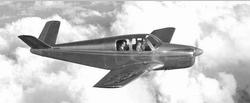NTSB Probable Cause Report Indicates The Plane Broke Apart In Flight
This could be described as the very epitome of an avoidable accident. The NTSB has released its probable cause report from an accident which occurred near Glencoe, MN, March 21st in which a Beechcraft Bonanza went down, resulting in the fatal injury of the three people and three dogs on board.

According to the report, the non-instrument-rated private pilot was conducting the accident flight under visual flight rules without a flight plan. Witnesses in the area reported hearing the airplane flying from east to west but could not see the airplane due to the low clouds and reduced visibility. Subsequently, the witnesses heard a loud crack and then the impact of the airplane with the ground. Based upon witness statements and reported weather conditions near the accident site, the flight encountered instrument meteorological conditions. The distribution of the wreckage was consistent with an in-flight breakup starting with the separation of the left wing followed by the separation of the empennage. All fracture surfaces were consistent with overload failure. An examination of the remaining systems revealed no anomalies. There was no record of the pilot receiving a preflight weather briefing from a recorded source.
The pilot, age 52, held a private pilot certificate with a single engine land rating. He was issued a third class airman medical certificate on October 28, 2011. The certificate contained the limitation “must wear corrective lenses.” At the time of application for his airman medical certificate, the pilot reported a total time of 250 hours, and no flight time within the preceding six months.
The pilot’s family provided the National Transportation Safety Board (NTSB) Investigator-in-Charge two logbooks for review. A third logbook, the pilot’s training logbook was not requested and was retained by the family; 57.5 hours of flight instruction and 41.1 hours of solo flight time were recorded in this logbook. The first logbook covered the time between June 23, 2005, and June 13, 2009. During this time, the pilot logged 117 hours in an Alon A-2A. There were no endorsements recorded in this logbook and no instrument flight hours logged.
The second logbook covered the time between November 10, 2011, and March 11, 2012. During this time, the pilot logged 32.6 hours of flight time, 24.2 of which were logged in the accident airplane. On November 12, 2011, the pilot completed the requirements of a flight review and received a pilot-in-command endorsement for the operations of complex aircraft. The two logbooks did not reflect any instrument training or instrument experience. The pilot did not have an endorsement for operating high performance aircraft.
The accident airplane, a Beech 35 (serial number D1113), was manufactured in 1947. It was registered with the FAA on a standard airworthiness certificate for normal operations.
The wreckage was scattered over 900 feet between two plowed fields divided by a field service road. The northern field was a dormant cornfield and the southern field was a dormant soybean field. Small red paint chips were scattered throughout the entire debris field and along the flight path described by the ground witness.
The National Transportation Safety Board determines the probable cause(s) of this accident to be the non-instrument-rated pilot’s continued flight into instrument meteorological conditions, which resulted in the design limits of the airplane being exceeded and an in-flight breakup.
(Model 35 Bonanza pictured in file photo. Not accident airplane)
 Aero-News: Quote of the Day (04.17.24)
Aero-News: Quote of the Day (04.17.24) ANN's Daily Aero-Linx (04.17.24)
ANN's Daily Aero-Linx (04.17.24) Airborne-Flight Training 04.17.24: Feds Need Controllers, Spirit Delay, Redbird
Airborne-Flight Training 04.17.24: Feds Need Controllers, Spirit Delay, Redbird Airborne 04.16.24: RV Update, Affordable Flying Expo, Diamond Lil
Airborne 04.16.24: RV Update, Affordable Flying Expo, Diamond Lil Airborne 04.11.24: SnF24!, King's 50th, Top Rudder, Aileronics
Airborne 04.11.24: SnF24!, King's 50th, Top Rudder, Aileronics



